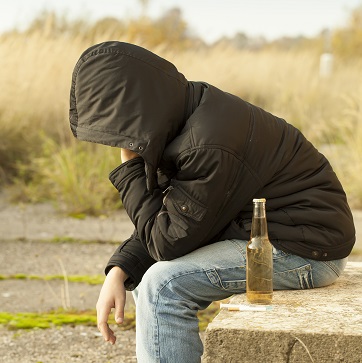How Social Connections Influence Drug And Alcohol Use In Homeless Youth
Homelessness is a socioeconomic condition that directly affects well over a million Americans in any given year. For a number of reasons, homeless people are significantly more likely than the rest of the population to develop serious problems with substance abuse or addiction. In a study published in September 2013 in the journal Addiction, researchers from the RAND Corporation examined the types of social connections that help define the ways in which homeless teenagers and young adults use or abuse drugs or alcohol.
Homelessness Statistics
No one really knows how many people in America are homeless at any particular point in time. However, according to recent figures compiled by the federal Substance Abuse and Mental Health Services Administration (SAMHSA), on a representative day in 2010, at least 400,000 individuals in the U.S. didn’t have a fixed home address and either lived on the streets or in some sort of shelter or temporary housing. In a 12-month period that overlapped parts of both 2009 and 2010, more than 1.5 million people qualified as homeless. Some homeless people only lack permanent housing for relatively short amounts of time; however, on a typical day, more than 100,000 Americans lack permanent housing on a long-term basis.
Who Makes Up For Most Of The Homelessness In America?
In the U.S., men and boys experience homelessness almost twice as often as girls and women. Almost 22 percent of all homeless Americans are children or teenagers below the age of 18. Young adults between the ages of 18 and 30 make up another 23.5 percent of the U.S. homeless population. However, adults between the ages of 31 and 50 have the highest overall rate of homelessness. In descending order, the three American ethnic groups most likely to experience homelessness are non-Hispanic whites, African-Americans and Hispanic whites.
Homelessness And Substance Abuse
Current estimates indicate that as many as 50 percent of all long-term homeless Americans are affected by serious problems with substance abuse or substance addiction. When rates for drug- or alcohol-related issues in time periods before or after homelessness are taken into account, this figure rises to more than 80 percent. In many cases, problems with substance abuse or addiction appear before homelessness occurs and contribute to the changing life circumstances that cause an affected individual to lose his or her attachments to a permanent home. However, in other cases, the difficulties of homelessness contribute to the onset of excessive, dysfunctional drug or alcohol consumption. Mental illness is also a frequent contributor to the declining life circumstances of homeless people.
Social Connections Important Regarding Drug Use
In the study published in Addiction, the RAND Corporation researchers sought to identify the people who are most likely to participate in drug or alcohol use with homeless teenagers and young adults. They conducted their work with the help of 419 homeless people between the ages of 13 and 24 from the greater Los Angeles area. Each of these individuals was asked to name 20 people whom they interacted with socially. In addition, the participants were asked to detail their 20 social contacts’ relevant background information and level of involvement with drug or alcohol use.
After examining their data, the researchers concluded that, in descending order, homeless youths are most likely to engage in alcohol use with their intimate sexual partners and people in their social circles who use drugs, engage in dangerous sexual practices, act as opinion formers, provide some sort of physical or emotional support, and have popular social standing. They also concluded that, in descending order, homeless youths are most likely to engage in drug use with their intimate sexual partners and people in their social circles who drink alcohol, engage in dangerous sexual practices, act as opinion formers, provide physical or emotional support, and have popular social standing.
The Significance Of Homelessness And Substance Abuse
Based on their findings, the authors of the study concluded that homeless teenagers and young adults tend to share drug and alcohol use with peers who have more than one clear risk for substantial problems with health or well-being, as well as with peers who in some way dominate or determine the ways in which they view and interact with the world. The authors believe that public health officials and abuse/addiction specialists can use this information as the basis for improved efforts to reach homeless youths affected by substance use/abuse and reduce their chances of developing or continuing dangerous patterns of drug or alcohol intake.
Read About How Volunteering Can Aid Your Own Recovery




